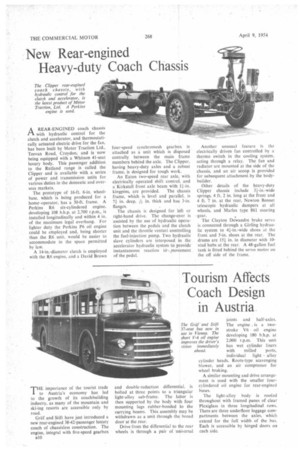Tourism Affects Coach Design in Austria
Page 44

Page 45

If you've noticed an error in this article please click here to report it so we can fix it.
THE importance of the tourist trade
to Austria's economy has led to the growth of its coach building industry, as many of the mountain and ski-ing resorts are accessible only by road.
Graf and Stift have just introduced a new rear-engined 38-42-passenger luxury coach of chassisless construction. The engine, integral with five-speed gearbox 810
and double-reduction differential, is bolted at three points to a triangular light-alloy sub-frame. The latter is then supported by the body with four mounting lugs rubber-bonded to the carrying beams. This assembly may be withdrawn as a unit through the broad door at the rear.
Drive from the differential to the rear wheels is through a pair of universal
joints and half-axles. The engine . is a twostroke V6 oil engine developing 180 b.h.p. at 2,000 r.p.m. This unit has wet cylinder liners
with milled ports, individual light alloy cylinder heads. Roots-type scavenging blower, and an air compressor for wheel braking.
A similar mounting and drive arrangement is used with the smaller fourcylindcred oil engine for rear-engined buses.
The light-alloy body is roofed throughout with framed panes of clear Plexiglass in three longitudinal rows. There are three underfloor luggage compartments between the axles, which extend for the full width of the bus. Each is accessible by hinged doors on each side. Adjacent to the fully forward driver's position is a scat for the guide or an additional passenger. Fitted equipment includes a wireless set, tape recorder, public-address system and heater.
Another new Graf and Stift model, now being adopted by the Vienna City Transport system, is a 37-seat bus. The engine and driver's seat are forward of the front axle, resulting in a considerable front overhang but a smaller wheelbase.
The appearance of this design is improved by shortening the bonnet and partially recessing the headlamps in the side panels. Close visibility is enhanced by placing the steering column and controls next to the engine.
The power unit is a twostroke V-4 oil engine similar to the six-cylindered engine. This is rated at 125 b.h.p. at 2.000 r.p.m. The three passenger doors at the side are pneumatically operated by the conductor from his booth just over the drive axle. An external rear-view mirror simplifies his keeping an eye on the extra-wide entrance door at the back.
The Austrian Saurer Co., has introduced a short-wheelbase rear-engined touring coach with long rear overhang. Seating capacity is 32, and the last two rows of seats, as well as the engine, are carried behind the back axle. .
The engine is a four-stroke six cylinder-in-line compression-ignition unit rated at 130 b.h.p. at 2,200 r.p.m. The bore is 110 mm. and the stroke 140 mm., affording a capacity of 8 litres. The compression ratio is 17 to 1.
Steyr, Austria's largest engineering enterprise, produces tractors. stationary engines, ball bearings, motorcycles and assembled Fiat cars, and builds a limited range of commercial vehicles. All the lorries. of 4-ton payload, and buses use a similar engine and are based on a common chassis, which is supplied in two wheelbases.
The two bus bodies, seating 25 and 29 respectively, are conventional in construction. The four-stroke fourcylindered oil engine of 5.3-litre capacity yields 90 b.h.p. It is understood that these buses are now being exported to the Far East.
Austria's vehicle exports are mostly lorries, with Yugoslavia accounting for nearly half the total sales last year. Other principal markets are Bulgaria, Western German y and Rumania.




































































































